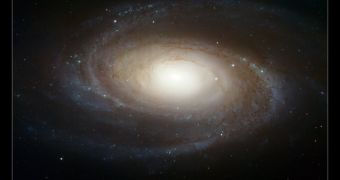The spiral galaxy M81 is tilted at an oblique angle to the line of sight and gives a spectacular view of its spiral structure. NASA Hubble Space Telescope sent back the sharpest image ever taken of this "Grand Design" galaxy.
Messier 81 (also known as NGC 3031 or Bode's Galaxy) is a spiral galaxy about 12 million light-years away, in the constellation Ursa Major. M81 is one of the most striking examples of a grand design spiral galaxy, with near perfect arms spiraling into the very center.
Despite being located at such a great distance, Hubble has been able to capture incredible levels of detail, like individual stars, along with open star clusters, globular star clusters and even glowing regions of fluorescent gas.
This galaxy is one of the brightest that can be seen from Earth, having an apparent magnitude of 6.8, just at the limit of naked-eye visibility, around as much as the faintest stars observable with naked eye.
The perfectly aligned spiral arms of M81 going all the way to the nucleus are made up of young, bluish, hot stars formed in the past few million years, but also contain older stars that were born during a star formation period around 600 million years ago.
The image shows UV light from the hot young stars that make the surrounding clouds of hydrogen gas shine, as well as a large number of sinuous dust lanes also going all the way into the nucleus of M81.
Resembling Milky Way in some aspects, M81 has a central bulge significantly larger than Milky Way's, with a huge black hole of 70 million solar masses located at the center, more than 15 times more massive than the one found at the core of our own galaxy.
According to astronomers, M81 may be going through a surge of star formation throughout its spiral arms, caused by a close encounter with its nearby spiral galaxy NGC 3077 and a nearby starburst galaxy (M82) about 300 million years ago.

 14 DAY TRIAL //
14 DAY TRIAL //